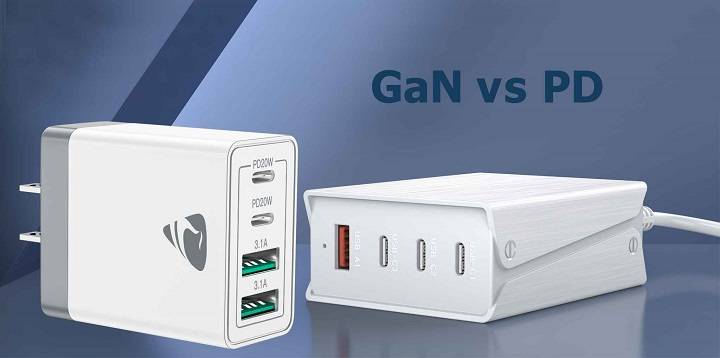Table of Contents
In the fast-paced world of technology, where devices are becoming increasingly powerful and compact, the need for efficient charging solutions has never been more pressing. Enter PD chargers, a revolutionary advancement in charging technology that promises faster, smarter, and more versatile charging for a wide range of devices. In this comprehensive guide, we delve deep into the realm of PD chargers, exploring what they are, how they work, their benefits, and their implications for the future of charging technology.
What is PD Charger?

PD, or Power Delivery, chargers are a type of fast-charging technology that allows devices to charge at higher speeds than traditional chargers. Unlike standard USB chargers, which deliver a fixed voltage and current to devices, PD chargers are capable of dynamically adjusting their output to match the specific power requirements of the connected device. This flexibility enables PD chargers to deliver optimal charging speeds while minimizing the risk of overcharging or overheating.
How Do PD Chargers Work?
At the heart of PD chargers is a sophisticated communication protocol known as USB Power Delivery. This protocol allows devices to communicate with chargers and negotiate the optimal charging parameters, including voltage and current levels. By exchanging information between the charger and the device, PD chargers can deliver the precise amount of power required to charge the device quickly and safely.
Key Components of PD Chargers
- USB-C Connector: PD chargers typically use USB-C connectors, which offer several advantages over traditional USB connectors, including higher data transfer speeds, reversible plug orientation, and support for higher power delivery.
- Power Delivery Controller: This component manages the communication between the charger and the connected device, negotiating the optimal charging parameters based on the device’s requirements and the capabilities of the charger.
- GaN Technology: Many PD chargers utilize Gallium Nitride (GaN) technology, which allows for higher efficiency and power density compared to traditional silicon-based chargers. GaN chargers are smaller, lighter, and more energy-efficient, making them ideal for portable devices.
Benefits of PD Chargers

- Faster Charging: PD chargers can deliver higher power levels than standard chargers, resulting in significantly faster charging times for compatible devices.
- Universal Compatibility: Thanks to the USB Power Delivery protocol, PD chargers are compatible with a wide range of devices, including smartphones, tablets, laptops, and even some appliances.
- Smart Charging: PD chargers can intelligently adjust their output based on the connected device’s power requirements, ensuring optimal charging efficiency and safety.
- Compact and Portable: With the adoption of GaN technology, PD chargers have become smaller and lighter without compromising on performance, making them ideal for travel and everyday use.
Implications for the Future
The widespread adoption of PD chargers represents a significant shift in the way we power our devices. As more manufacturers embrace this technology, we can expect to see even faster charging speeds, greater compatibility, and improved energy efficiency. PD chargers also pave the way for the development of new devices and applications that rely on high-speed charging, such as electric vehicles and smart home appliances.
In conclusion, PD chargers are a game-changer in the world of charging technology, offering faster, smarter, and more versatile charging solutions for a wide range of devices. With their ability to deliver optimal charging speeds while minimizing the risk of overcharging or overheating, PD chargers are poised to become the go-to choice for consumers looking to power their devices quickly and efficiently. As the technology continues to evolve, we can expect to see even greater advancements in charging technology, paving the way for a future where powering our devices is faster, safer, and more convenient than ever before.
The Evolution of Charging Technology

The evolution of charging technology has been nothing short of remarkable. From the early days of bulky AC adapters to the sleek and efficient PD chargers of today, charging technology has undergone significant advancements to meet the growing demands of consumers. PD chargers represent the culmination of years of research and innovation, offering a glimpse into the future of charging technology.
One of the key drivers behind the development of PD chargers is the increasing power demands of modern devices. As smartphones, tablets, and laptops become more powerful, their energy requirements have also increased, leading to longer charging times and greater strain on traditional charging solutions. PD chargers address this challenge by delivering higher power levels in a more efficient and intelligent manner, resulting in faster charging times and improved overall performance.
The Role of USB Power Delivery
Central to the functionality of PD chargers is the USB Power Delivery protocol. This standardized communication protocol allows devices to negotiate the optimal charging parameters with the charger, including voltage, current, and power levels. By enabling devices to communicate with chargers in real-time, USB Power Delivery ensures that devices receive the precise amount of power they need to charge quickly and safely.
Moreover, USB Power Delivery is not limited to a specific type of device or connector. This universality makes PD chargers incredibly versatile, as they can be used to charge a wide range of devices, including smartphones, tablets, laptops, and even some appliances. This compatibility is further enhanced by the widespread adoption of USB-C connectors, which offer several advantages over traditional USB connectors, including higher data transfer speeds and reversible plug orientation.
The Advantages of GaN Technology

Another key innovation driving the advancement of PD chargers is Gallium Nitride (GaN) technology. GaN is a semiconductor material that offers several advantages over traditional silicon-based chargers, including higher efficiency, higher power density, and lower heat generation. These benefits allow GaN chargers to be smaller, lighter, and more energy-efficient than their silicon counterparts, making them ideal for portable devices and on-the-go charging.
Moreover, GaN chargers are also more environmentally friendly than traditional chargers. Their higher efficiency means that less energy is wasted during the charging process, reducing overall energy consumption and carbon emissions. As consumers become increasingly conscious of their environmental footprint, the adoption of GaN chargers represents a significant step towards a more sustainable future.
The Future of Charging Technology
Looking ahead, the future of charging technology looks brighter than ever. With the continued evolution of PD chargers and USB Power Delivery, we can expect to see even faster charging speeds, greater compatibility, and improved energy efficiency. Moreover, as manufacturers continue to integrate GaN technology into their chargers, we can anticipate further reductions in size, weight, and environmental impact.
Furthermore, the implications of PD chargers extend beyond consumer electronics. The rise of electric vehicles (EVs) and renewable energy sources has created new opportunities for high-speed charging technology. PD chargers have the potential to revolutionize the way we charge EVs, making electric transportation more accessible and convenient than ever before. Similarly, PD chargers could play a significant role in the development of smart grid systems, enabling more efficient energy distribution and management.
Related Post:
Revolutionize Your Tunes: Top iPod FM Transmitters for Seamless Sound Everywhere!
Unveiling the Scosche FAI 3A: Elevating Your Audio Experience
Unleashing the Power of Wireless Connectivity: The Bluetooth Radio Transmitter
Unlocking Convenience: The Evolution of Wireless Charging Pads for Your Car
PD chargers represent a significant advancement in charging technology, offering faster, smarter, and more versatile charging solutions for a wide range of devices. With their ability to deliver optimal charging speeds while minimizing energy waste and environmental impact, PD chargers are poised to become the standard for powering our devices in the years to come. As the technology continues to evolve, we can expect to see even greater advancements in charging technology, paving the way for a future where powering our devices is faster, safer, and more sustainable than ever before.

